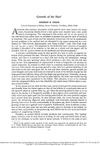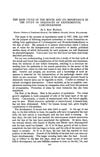TLDR Keratin 19 helps identify skin stem cells, with its presence varying by body location, age, and culture stage.
This study evaluated keratin 19 (K19) as a marker for skin stem cells, using a mouse model to identify these cells as [3H]thymidine-label-retaining cells. K19 was found to be a marker for skin stem cells in hair follicles, with expression varying by body site, donor age, and culture time. K19 was present in hair follicles but absent in interfollicular epidermis at hairy sites, while at glabrous sites, K19-positive cells were located in deep epidermal rete ridges. The study found a higher proportion of K19-positive cells in newborn foreskins compared to older ones, correlating with the variation in keratinocyte culture lifespan and potentially explaining why children heal faster than adults. The findings suggested that K19 expression could be a valuable tool for characterizing skin stem cells in various conditions.
63 citations
,
July 2006 in “British Journal of Dermatology” Psoriasis causes changes in certain keratins and shrinks sebaceous glands in the scalp.
28 citations
,
September 1995 in “Biochemistry and Cell Biology” Merkel cells are more densely found in hairless skin areas like palms and soles.
43 citations
,
August 1994 in “Journal of Investigative Dermatology” 85 citations
,
July 1993 in “The journal of investigative dermatology/Journal of investigative dermatology” 198 citations
,
November 1989 in “The Journal of Cell Biology” Keratin K14 expression varies between hair follicles and epidermis, affecting cell differentiation.
238 citations
,
May 1989 in “Journal of Investigative Dermatology” 124 citations
,
December 1988 in “Differentiation” Trichocytic differentiation starts in cells with epithelial cytokeratins, transitioning to trichocytic cytokeratins in hair and gradually in nails.
248 citations
,
April 1988 in “Differentiation” Human and bovine hair follicles have distinct cytokeratins specific to hair-forming cells.
38 citations
,
January 1988 135 citations
,
November 1987 in “Differentiation” Outer root sheath cells consistently express certain keratins influenced by their environment.
159 citations
,
October 1986 in “The Histochemical Journal” 292 citations
,
October 1985 in “The Journal of Cell Biology” Keratins and filaggrin change as fetal skin develops, marking key stages of skin formation.
 521 citations
,
January 1954 in “Physiological Reviews”
521 citations
,
January 1954 in “Physiological Reviews” Hair growth is cyclic and influenced mainly by local factors.
 111 citations
,
March 1951 in “Annals of the New York Academy of Sciences”
111 citations
,
March 1951 in “Annals of the New York Academy of Sciences” Understanding the mouse hair cycle is crucial for cancer research.
50 citations
,
July 2008 in “British Journal of Dermatology” 138 citations
,
March 2007 in “Experimental cell research” Only a few hair-specific keratins are linked to inherited hair disorders.
276 citations
,
January 2005 in “International review of cytology” More research is needed to understand how hair keratins work and their role in hair disorders.
 199 citations
,
January 2004 in “The International Journal of Developmental Biology”
199 citations
,
January 2004 in “The International Journal of Developmental Biology” Hair follicle growth and development are controlled by specific genes and molecular signals.
29 citations
,
April 2003 in “Experimental dermatology” Human hair follicles grown in vitro maintain normal keratin patterns and structure.


